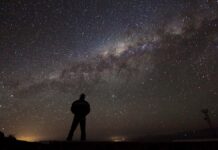Tonight, November 23, 2025, the moon is visible as a Waxing Crescent, with approximately 10% of its surface illuminated. This phase marks the beginning of the moon’s journey toward fullness after a period of near-total darkness. If you’re looking up, you’ll be able to see the dark regions of the moon.
What You Can See
Without optical aids, observers can make out the Fecunditatis and Crisium lunar maria (dark, basaltic plains). With binoculars or a telescope, the Endymion Crater is visible in the upper right quadrant (or bottom left if you’re in the Southern Hemisphere).
The Lunar Cycle Explained
The phases of the moon are a result of its 29.5-day orbital cycle around Earth. The amount of sunlight illuminating the moon changes as it orbits, creating the distinct phases we observe. While we always see the same side of the moon, its appearance shifts from fully dark to fully bright and back again.
There are eight primary moon phases:
- New Moon: The moon is positioned between Earth and the sun, rendering its visible side dark.
- Waxing Crescent: A sliver of light appears on the right side (in the Northern Hemisphere).
- First Quarter: Half of the moon is lit on the right side.
- Waxing Gibbous: More than half of the moon is illuminated, approaching fullness.
- Full Moon: The entire face of the moon is bright and visible.
- Waning Gibbous: The moon begins to lose light on the right side.
- Third Quarter (or Last Quarter): Another half-moon, with the left side illuminated.
- Waning Crescent: A thin sliver of light remains on the left side before the cycle repeats.
Next Full Moon: A Supermoon Finale
The next full moon will occur on December 4, marking the third consecutive supermoon of this cycle. The last full moon was on November 5. Supermoons appear larger and brighter because they occur when the moon is closest to Earth in its orbit.
The lunar cycle is a fundamental rhythm of our planet’s natural world, influencing everything from tides to cultural traditions. Observing these phases provides a direct connection to the cosmos.





























